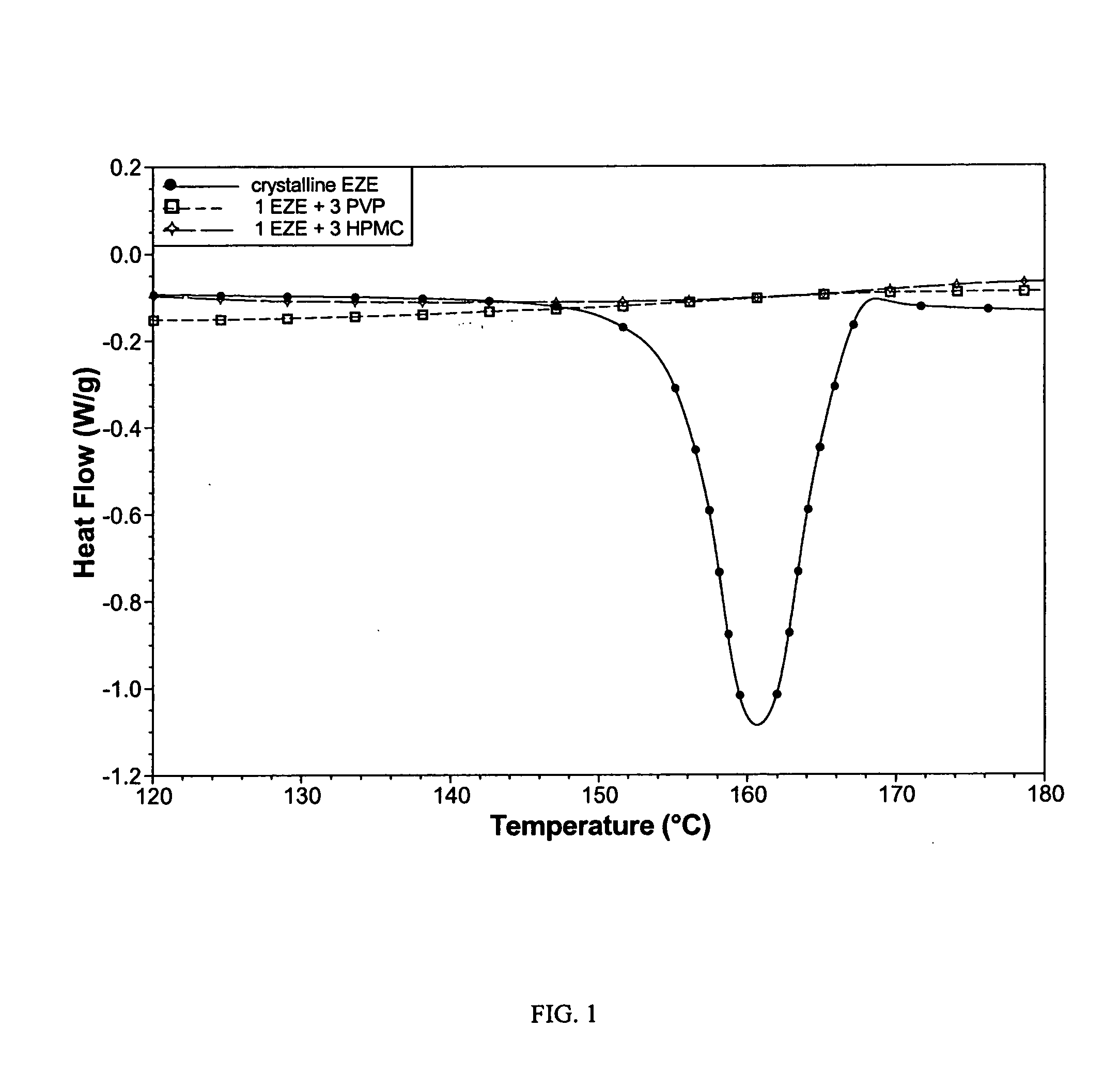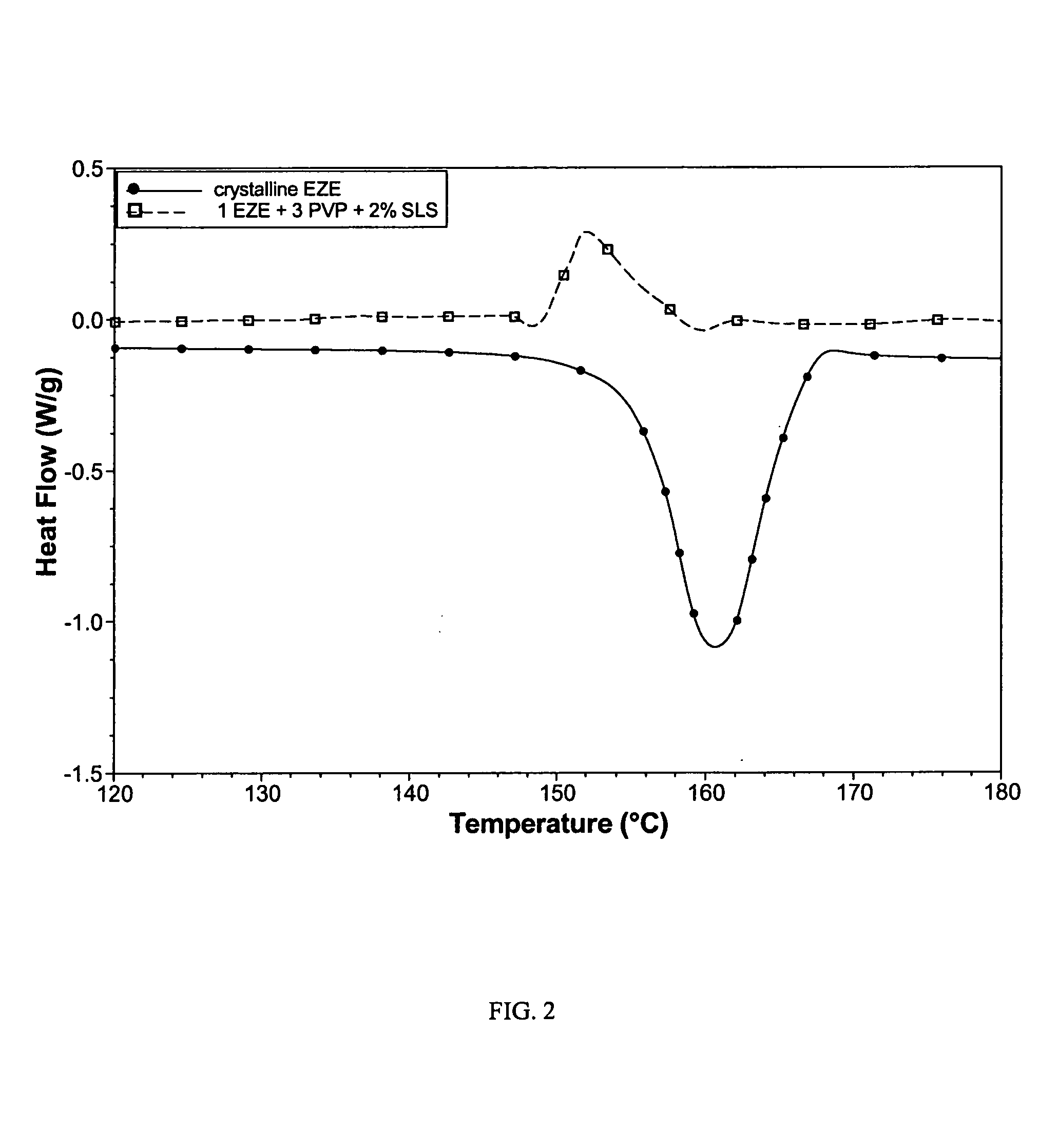Amorphous ezetimibe and the production thereof
a technology of ezetimibe and ezetimibe, which is applied in the direction of biocide, drug composition, metabolic disorder, etc., can solve the problem that the solvent composition is not sufficient to maintain the polymer in solution, and achieve the effect of reducing residual solvent content, and increasing the density of powder
- Summary
- Abstract
- Description
- Claims
- Application Information
AI Technical Summary
Benefits of technology
Problems solved by technology
Method used
Image
Examples
example 1
[0081]Two EZE spray dried products were produced from solutions containing concentration-enhancing polymers. One powder contained 1 EZE: 3 hydroxypropylmethylcellulose (HPMC) from 50% dichloromethane / 50% methanol, while the other contained 1 EZE: 3 polyvinylpyrrolidone (PVP) from ethanol. The organic solvent solutions were spray dried using an SD-Micro® spray dryer (Niro, Inc.) to produce powder products.
[0082]Both products contained only amorphous EZE, as revealed by DSC (FIG. 1).
example 2
[0083]The polyvinylpyrrolidone formula of Example 1 was modified by adding 2% (w / w) sodium lauryl sulfate (SLS) to the ethanol solution prior to spray drying to produce a powder.
[0084]This product contained only amorphous EZE, as revealed by DSC (FIG. 2).
[0085]The dissolution properties of the spray dried powder were compared to the crystalline form of the drug. The spray dried product was hand-filled into hard gelatin capsules (Qualicaps®, Shinogi) with an additional 15% (w / w) croscarmellose sodium disintegrant. USP apparatus II (paddles) (VK 7010®, Varian Inc.) was used, with a bath temperature of 37° C. and a paddle speed of 100 rpm for 240 minutes. The dissolution medium was deaerated, filtered USP water.
[0086]A ten-fold increase in EZE aqueous solubility was measured for the amorphous spray dried powder compared to the crystalline form (FIG. 3).
example 3
[0087]The pharmacokinetics of crystalline EZE and the amorphous 1 EZE: 3 PVP+2% SLS spray dried powder were studied in male Sprague Dawley rats in the fasted state. Six rats were single-dosed with either 100 mg / kg crystalline EZE or an equivalent amount of the amorphous EZE of Example 2.
[0088]The amorphous EZE formulation enhanced the pharmacokinetics of ezetimibe and ezetimibe glucuronide (EZE-G), its active metabolite (Table 1, FIG. 4A-B). The amorphous composition of Example 2 increased the maximum plasma concentration (Cmax) 3.7-fold for EZE and 1.9-fold for EZE-G, while decreasing the time to Cmax by 5-7 hours. Drug exposure, as measured by the 0-24 hour area under the curve (AUC0-24h), increased 2.6-fold for EZE and 1.6-fold for EZE-G.
TABLE 1Pharmacokinetic properties of crystalline vs. amorphous EZE.CmaxtmaxAUC0–24 hmoleculedrug form(ng / mL)(h)(ng · h / mL)EZEcrystalline5.18.064.2amorphous19.10.8164compositionEZE-Gcrystalline2456.03131amorphous4610.84990composition
PUM
| Property | Measurement | Unit |
|---|---|---|
| size | aaaaa | aaaaa |
| melting point | aaaaa | aaaaa |
| diameter | aaaaa | aaaaa |
Abstract
Description
Claims
Application Information
 Login to View More
Login to View More - R&D
- Intellectual Property
- Life Sciences
- Materials
- Tech Scout
- Unparalleled Data Quality
- Higher Quality Content
- 60% Fewer Hallucinations
Browse by: Latest US Patents, China's latest patents, Technical Efficacy Thesaurus, Application Domain, Technology Topic, Popular Technical Reports.
© 2025 PatSnap. All rights reserved.Legal|Privacy policy|Modern Slavery Act Transparency Statement|Sitemap|About US| Contact US: help@patsnap.com



